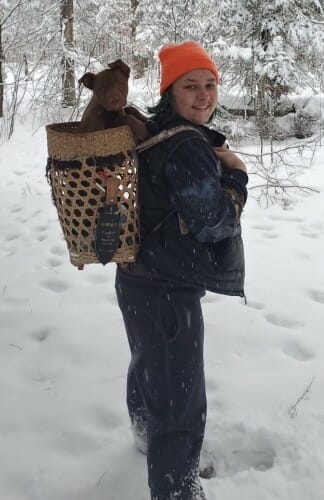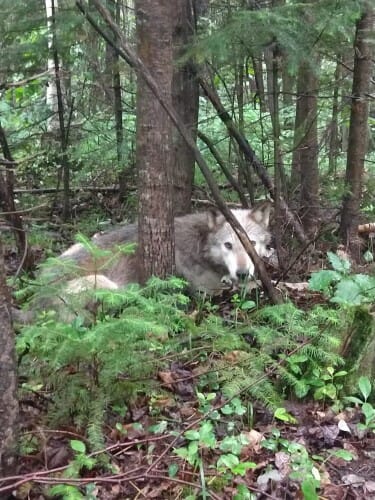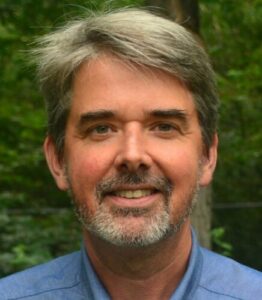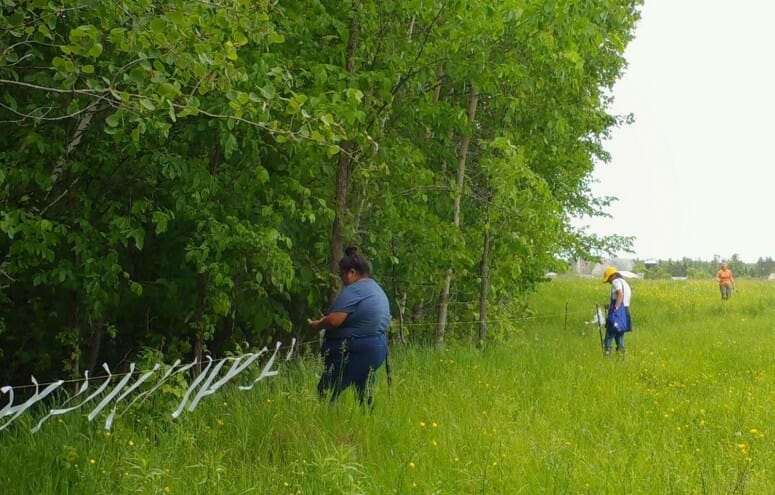
Abi Fergus says understanding tribal citizens’ attitudes toward wolves helped her stay in touch with the human dimension of her research. COURTESY OF ABI FERGUS
Abi Fergus dreamed of working with wolves from age 11, a dream that became an opportunity to help a Wisconsin tribe shape a future shared with the animal they call Ma’iingan.
While working on a graduate degree at the University of Wisconsin–Madison’s Carnivore Coexistence Laboratory, Fergus went to work for the Bad River Band of Lake Superior Chippewa as the tribe’s wildlife specialist.
“It was a dream job,” says Fergus, who had interned with the tribe before graduate school. “I kind of took the gamble that I could handle full-time school on top of the work, and my advisor Adrian Treves, my supervisor Naomi Tillison, and tribal leadership have helped me balance both.”
Fergus worked with tribal members on the Bad River Reservation — nearly 200 square miles in northern Wisconsin just west of Michigan’s upper peninsula — to update the tribe’s Ma’iingan Relationship Plan, or wolf relationship plan, originally written by her mentor and predecessor as wildlife specialist, Lacey Hill-Kastern.
The project drew on research she’d conducted for both her senior thesis as an undergrad at Alma College in Michigan and her UW–Madison graduate degree completed in 2020. As an Alma student, Fergus talked with farmers to understand the needs and concerns that influenced their relationships with predators, conversations that helped her foster connections with Wisconsin farmers.
With UW–Madison wildlife biologist Adrian Treves, Fergus studied non-lethal predator deterrents — methods like flags, lights and noisemakers deployed on six farms to protect pets and farm animals from wolves or other predators. While the study was small, results indicated that lights and flagging could have reduced coyote visits to livestock pasture.
“It was really beneficial for me to have done that field work, and then in the fall, finish writing my updated Ma’iingan plan, because at that point, I had a lot of on-the-ground experience,” says Fergus. “I wouldn’t have been able to really write a meaningful plan if I hadn’t already been doing that work and experiencing those relationships with farmers and learning from them what they know, based on living on the landscape with predators.”
Both Fergus and Treves say collaborative projects with tribes help uphold the core values of coexistence, and understanding the tribal citizens’ attitudes toward wolves can help the lab stay in touch with the human dimension of their research, and figure out how their findings might work in different settings.

Gimiwan, the last radio-collared wolf on the Bad River Reservation, and his breeding partner are part of the Mashkiiziibii Pack on the nearly 200 square-mile reservation in northern Wisconsin. COURTESY OF ABI FERGUS
“Anishinaabeg (Ojibwe people) have the most positive attitude towards wolves we’ve ever seen,” Treves says. “That’s helpful to understand how coexistence would be different in a socio-cultural setting where there’s a lot of tolerance for wolves and a very low inclination to kill them illegally, which we found as a major cause of death across Wisconsin.”
The tribe’s plan includes survey data from a former Carnivore Coexistence graduate student, Victoria Shelley, who polled both tribal and non-tribal respondents about wolf relationship practices in years before the 2021 wolf hunt in Wisconsin. Overwhelmingly, tribal respondents favored protecting wolves. A large majority of tribal respondents said they believe wolves are essential to maintain the balance of nature. And while a majority of non-tribal respondents said they believe there should be a public hunting or trapping season allowed for wolves immediately or in a sustainable fashion, only a minority of tribal respondents said the same.
According to Treves, collaborating with tribes allows them to draw from not just their own Western scientific knowledge, but also from the Anishinaabeg traditional knowledge. Fergus enjoys working with both traditions and learning how the Bad River Tribe lives regeneratively and coexists with local species.
“When you get familiar with the work that tribes do, you see that they’re really leading the way and employing excellent science, but also valuing what has been passed down for generations,” Fergus says. “That is a really holistic way to learn. And I’ve been really grateful to be learning from the tribe.”
Fergus and the tribe determined that instead of setting a specific quota for wolf numbers on the reservation, they will work with tribe members on maintaining a sustainable coexistence. According to the plan, the goal is to have three wolf packs on the reservation, but not to set a hard upper limit to how many wolves they can have. The tribe uses non-lethal deterrents and outreach to continue their history of coexistence with wolves and assist neighboring farmers to coexist as well.
While Fergus found her field research interesting, and its implications valuable in several spheres, the work doesn’t end after writing the thesis, Treves says. The next step is communicating research with the public, to better inform policy. Fergus has spoken to dozens of nongovernmental organizations about predator policy and, with Treves, to media in the hope that their research will find ears that can listen, learn and make a change.

Adrian Treves
“We reach out to all kinds of broadcast media and post things online and on forums,” Treves says. “We’re hoping to influence public policy and public opinion directly because predators are so widely misunderstood and public policy, currently in the U.S., is quite regressive, in my opinion.”
In January 2020, Fergus and the tribe hosted a Ma’iingan Symposium at the Northern Great Lakes Visitor Center in Ashland to bring together conversations and knowledge about the wolf between community members and tribal, state and federal wildlife agencies. People of all walks of life came away from the symposium with something new, from a farmer who benefited from sharing her story in a breakout session and brainstorming with the group on new ways to coexist with carnivores, to a federal agency employee who said the symposium helped him understand that when he lost his bird-hunting dog in an unusual encounter with a wolf, the wolf had just been doing its job and defending its own family.
In January 2021, the Trump administration delisted gray wolves from the Endangered Species Act, removing many protections afforded wolves. Fergus, Ojibwe tribal interests and Treves’ lab spent several weeks preparing to petition against a hunt. In February, a judge ordered the Wisconsin Department of Natural Resources to hold a three-day wolf hunt in which hunters in several parts of northern Wisconsin could shoot wolves without having to cite a threat to their property. Non-tribal hunters killed more than 200 wolves, beyond DNR quotas for the harvest.

As part of their wolf management plan, Bad River Tribe workers install deterrents like flags, lights and noisemakers that have kept predators apart from farms in UW–Madison research. COURTESY OF ABI FERGUS
Fergus says her research has helped her better understand how to focus the tribe’s plan. Anishinaabeg have taught her to respect the different roles and values of every living being. She wants to help federal and state agencies understand that killing predators doesn’t have to be the answer, that science supports alternative coexistence routes.
“It’s a lot more meaningful to be able to empower farmers and teach state and federal agencies this different path from our history of nearly eradicating carnivore species and acting like our only tool is killing carnivores, which is not supported by science or by Anishinaabe knowledge,” Fergus says. “I plan to continue having coexistence of carnivores be a huge focus in the wildlife program for the Bad River Tribe, because I see so many issues tying back to a broken relationship humans have with all the other members of our ecosystem.”
